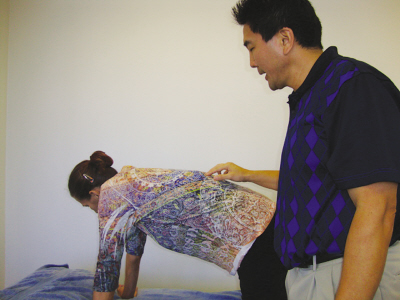 No one likes to endure aches and pains during work or play, or, for that matter, completing routine day-to-day activities such as housecleaning and yard work. Even standing, walking and sitting for short periods of time can be agonizing for those with ongoing, chronic pain. Physical therapy can help people return to their “pre-pain” condition and resume their life in comfort. A physical therapist can help people transition from chronic pain to a well-deserved quality of life in movement.
No one likes to endure aches and pains during work or play, or, for that matter, completing routine day-to-day activities such as housecleaning and yard work. Even standing, walking and sitting for short periods of time can be agonizing for those with ongoing, chronic pain. Physical therapy can help people return to their “pre-pain” condition and resume their life in comfort. A physical therapist can help people transition from chronic pain to a well-deserved quality of life in movement.
SYMPTOMS & DIAGNOSIS
It all starts with an evaluation, summarizing physical deficiencies in or near the area of pain. For example, a typical patient with low back pain may demonstrate restricted range of motion (ROM) and/or pain with forward-bending, weakness (tingling and numbness) in the area of pain or in remote areas; poor posture and/or significant muscle spasms in the lower back area.
Diagnosis can include:
- limitation in joint range of motion (ROM)
- muscle inflexibility
- loss of strength or motor control
- abnormal postures
- inefficient movement patterns
- soft tissue changes (swelling & muscle spasms)
- All of the above issues directly or indirectly contribute to the cause of symptoms — most notably pain. As these impairments diminish, so will the symptoms.
TREATMENT
Treatment may include strengthening exercises, massage and education on proper mechanics with forward bending and sitting. Patients should also be shown the correct form to take with body movements or static positions that may contribute to the symptoms.
COMMON PROBLEM AREAS
Injuries may not necessarily be caused by a single traumatic event, such as a fall or a strain, but can be caused by repetitive overuse. Overuse causes gradual and cumulative wear and tear of tissues. Furthermore, improper movement patterns or postures can perpetuate this type of injury.
For musculoskeletal disorders, typical sites of treatment include the spine (neck, upper, lower back); hip and pelvis; lower extremities (knees, ankles, feet); and upper extremities (shoulders, elbows, wrists, hands). However, physical therapy supplements a variety of medical specialties such as neurology, cardiopulmonary, geriatrics, pediatrics and sports medicine.
Some may say that “getting old is not for sissies!” It doesn’t have to be that way. No one should have to live with pain. Don’t ever believe that pain is just a part of getting older. Research has shown that physical therapy can produce positive, meaningful change — regardless of age.
Ask your advising physician for a referral to physical therapy, as most health insurance plans reimburse for these services. It’s not uncommon to treat chronic pains for several months or up to years. Procrastination can actually prolong recovery and delay the potential to a “pre-pain” lifestyle. Recovery is possible with a combination of education and stylized exercise.
Don’t worry… exercise doesn’t have to be agonizing and grueling. It’s less arduous or complicated than you may think, with a satisfying pain-free reward!


Leave a Reply